RFP Transmittal Letter
[Your Name]
[Your Title/Position]
[Your Organization/Company Name]
[Your Address]
[City, State, ZIP Code]
[Email Address]
[Phone Number]
[Today's Date]
[Recipient's Name]
[Recipient's Title/Position]
[Recipient's Organization/Company Name]
[Recipient's Address]
[City, State, ZIP Code]
Subject: Request for Proposal (RFP) Transmittal
Dear [Recipient's Name],
I hope this letter finds you well. On behalf of [Your Organization/Company Name], I am pleased to submit our Request for Proposal (RFP) for [Project/Service/Initiative] as outlined in the attached document.
We have thoroughly reviewed your organization's capabilities and expertise, and we believe that you possess the required skills and experience to successfully execute [Project/Service/Initiative]. Our organization is excited about the potential partnership between our entities and the positive impact we can create together.
The enclosed RFP outlines the scope of work, project objectives, specific requirements, evaluation criteria, and submission guidelines. We kindly request that you review the RFP carefully and provide us with your comprehensive proposal in response to the outlined requirements.
Please adhere to the following timeline for the RFP process:
1. RFP Issuance Date: [Date of Issuance]
2. Deadline for Questions and Clarifications: [Deadline Date]
3. Proposal Submission Deadline: [Deadline Date]
4. Proposal Evaluation Period: [Dates]
5. Final Decision and Contract Award: [Date]
During the proposal evaluation period, we may request clarifications or additional information from you if necessary. All communications regarding the RFP should be directed to [Your Email Address].
To ensure a fair and competitive evaluation process, we request that you keep all aspects of this RFP confidential until the final decision is made. We also expect your proposal to remain valid for a period of [Timeframe] from the proposal submission deadline.
We are confident that your proposal will showcase your organization's capabilities and commitment to excellence. Should you have any questions or require further information, please feel free to contact us at [Your Phone Number] or [Your Email Address].
Thank you for considering our invitation to participate in this procurement process. We look forward to receiving your proposal and the possibility of working together to achieve our shared objectives.
Sincerely,
[Your Name]
[Your Title/Position]
[Your Organization/Company Name]
Formal RFP Transmittal Letter for Government Contract
Subject: Submission of Proposal in Response to RFP [RFP Number]
Dear [Recipient’s Name],
On behalf of [Your Company Name], I am pleased to submit our proposal in response to RFP [RFP Number] issued by [Agency/Organization Name]. Enclosed, please find our complete proposal package, including all required documentation and certifications.
Our team has carefully reviewed the requirements outlined in the RFP and has structured our response to demonstrate our ability to deliver high-quality services that meet and exceed your expectations. We are confident that our solution aligns with the objectives of your organization and complies fully with all stated criteria.
Should you require any clarifications or additional information, please do not hesitate to contact me directly at [Phone Number] or [Email Address]. We appreciate this opportunity and look forward to contributing to the success of your project.
Sincerely,
[Your Full Name]
[Title]
[Company Name]
Professional RFP Transmittal Letter for Corporate Services
Subject: Proposal Submission for RFP [RFP Title]
Dear [Recipient’s Name],
Please find attached our proposal in response to the Request for Proposal (RFP) [RFP Title]. We appreciate the opportunity to participate in this process and present our capabilities in delivering [specific service/product].
Our submission includes the technical proposal, pricing documents, compliance forms, and other required appendices. We have also included references and case studies demonstrating our successful track record in similar projects.
We believe that our experience, resources, and innovative approach uniquely position us to provide the best value to your organization. Thank you for considering our proposal, and we look forward to the possibility of working with you.
Sincerely,
[Your Name]
[Position]
[Company Name]
Preliminary RFP Transmittal Email
Subject: Initial Submission for RFP [RFP Number]
Dear [Recipient’s Name],
Attached is our preliminary response to RFP [RFP Number]. We are submitting this ahead of the final deadline to ensure you have sufficient time to review and provide feedback if necessary.
While this submission is complete according to the stated requirements, we are open to incorporating clarifications or additional details should they be requested. Our final submission will reflect any updates or refinements needed.
Thank you for allowing us the opportunity to participate in this process. We look forward to your review.
Best regards,
[Your Name]
[Company Name]
Informal RFP Transmittal Message for Clarification
Subject: Proposal Submission with Clarification Notes
Hi [Recipient’s First Name],
I’m sharing our proposal in response to your RFP [RFP Number]. We’ve included all requested documents, but I wanted to highlight a few clarifications regarding our scope and timeline, which are detailed in the cover section of the proposal.
Please let me know if you have any questions or need any supporting documents. We’re happy to provide additional information if it helps in your evaluation.
Thanks,
[Your First Name]
[Company Name]
Creative RFP Transmittal Letter Highlighting Innovation
Subject: Innovative Proposal Submission for RFP [RFP Number]
Dear [Recipient’s Name],
We are excited to submit our proposal for RFP [RFP Number]. Beyond meeting the technical requirements outlined in the request, our proposal emphasizes creative solutions and forward-thinking strategies designed to bring added value to your project.
Enclosed, you will find our comprehensive proposal package, including an overview of our innovative methodology, team expertise, and projected outcomes. We believe our unique approach sets us apart and aligns with your organization’s vision for growth and improvement.
Thank you for this opportunity. We look forward to the possibility of collaborating and driving innovation together.
Best regards,
[Your Name]
[Position]
[Company Name]
Quick RFP Transmittal Email for Late Submission
Subject: Proposal Submission for RFP [RFP Number]
Dear [Recipient’s Name],
Please accept our proposal submission for RFP [RFP Number]. We apologize for the tight timing and appreciate your consideration despite the short window.
The proposal package is complete and follows the guidelines provided in the RFP. Should there be any issues with the submission, please let us know immediately, and we will resolve them without delay.
Thank you for your understanding and support.
Sincerely,
[Your Name]
[Company Name]
Serious RFP Transmittal Letter for High-Value Project
Subject: Formal Submission of Proposal for RFP [RFP Number]
Dear [Recipient’s Name],
On behalf of [Your Company Name], we are honored to submit our proposal for the high-value project referenced in RFP [RFP Number]. We understand the significance of this project and have invested considerable effort in preparing a solution that reflects both technical excellence and operational efficiency.
The enclosed proposal includes our technical approach, pricing structure, compliance certifications, and supporting documentation. Our team is prepared to mobilize immediately upon award and ensure timely, high-quality delivery.
We respectfully request your consideration and look forward to your evaluation.
Sincerely,
[Your Full Name]
[Position]
[Company Name]
General RFP Transmittal Letter Template
Subject: Submission of Proposal for RFP [RFP Number]
Dear [Recipient’s Name],
Please accept this letter as confirmation of our submission in response to RFP [RFP Number]. Enclosed you will find the required documents, including technical and financial proposals, compliance forms, and appendices.
We appreciate the opportunity to present our capabilities and are confident that our proposal demonstrates alignment with the goals outlined in the RFP. Thank you for considering our submission.
Sincerely,
[Your Name]
[Company Name]
What is an RFP Transmittal Letter and Why Do You Need It?
An RFP transmittal letter is a cover letter that accompanies a proposal submitted in response to a Request for Proposal (RFP). Its purpose is to formally introduce the proposal, highlight key points, and express interest in working with the organization. Without it, a proposal may seem incomplete or impersonal. The letter sets the tone for how the proposal will be perceived and demonstrates professionalism.
Who Should Send an RFP Transmittal Letter?
- Business development managers.
- Project managers.
- Company executives (CEO, Director, or VP).
- Proposal coordinators or procurement teams.
- Consultants submitting on behalf of clients.
To Whom Should an RFP Transmittal Letter Be Addressed?
- The procurement officer or contracts manager listed in the RFP.
- The evaluation committee chair.
- The agency or department head.
- For corporate RFPs, the vendor relations manager or sourcing manager.
- When in doubt, address it to the “RFP Evaluation Committee” with courtesy.
When Do You Need to Send an RFP Transmittal Letter?
- Every time you submit a proposal package in response to an RFP.
- For preliminary submissions or drafts.
- When sending a revised or updated proposal.
- Even when the RFP does not explicitly request one, as a mark of professionalism.
How Do You Write an RFP Transmittal Letter?
- Review the RFP thoroughly to ensure compliance.
- Address the letter to the correct recipient by name.
- Clearly state the RFP number and title.
- Summarize your company’s qualifications and proposal highlights.
- Include a polite closing with contact details.
- Attach or enclose the complete proposal package.
- Send before or by the stated deadline.
Formatting Guidelines for an RFP Transmittal Letter
- Length: 1–2 pages maximum.
- Tone: Professional, formal, or serious depending on the project.
- Structure: Subject line, greeting, body (summary and confirmation), closing.
- Mode: Usually printed and attached, but emails are increasingly acceptable.
- Etiquette: Avoid jargon, maintain clarity, and use the organization’s preferred format if provided.
Requirements and Prerequisites Before Sending an RFP Transmittal Letter
- Ensure all RFP requirements are reviewed and addressed.
- Prepare all attachments: technical proposal, pricing, forms, certifications.
- Confirm the submission deadline.
- Assign a responsible person for sign-off.
- Proofread the letter for errors and compliance.
Follow-Up After Sending an RFP Transmittal Letter
- Confirm receipt of the proposal by contacting the procurement office.
- Be prepared to respond to clarification requests.
- Track evaluation timelines mentioned in the RFP.
- Avoid unnecessary follow-up unless requested by the issuing agency.
Common Mistakes to Avoid in RFP Transmittal Letters
- Failing to reference the correct RFP number.
- Submitting generic or copy-paste letters.
- Using overly long or irrelevant content.
- Addressing it to the wrong recipient.
- Forgetting to include contact details for follow-up.
Key Elements and Structure of an RFP Transmittal Letter
- Clear subject line with RFP number/title.
- Proper greeting with recipient’s name.
- Expression of intent to submit.
- Summary of company qualifications.
- Mention of enclosed documents.
- Closing with contact information.
- Signature of authorized person.
Tricks and Tips for Writing the Best RFP Transmittal Letter
- Keep it professional but concise.
- Tailor it to each specific RFP instead of reusing a template.
- Highlight one or two unique strengths of your proposal.
- Use plain language to ensure clarity.
- Double-check compliance with submission instructions.
Compare and Contrast: RFP Transmittal Letters vs. Cover Letters for Jobs
- Similarity: Both introduce the main document and express interest.
- Difference: RFP letters represent an organization, while job cover letters represent an individual.
- Alternative: Some companies replace transmittal letters with executive summaries, but a letter remains more personal and formal.

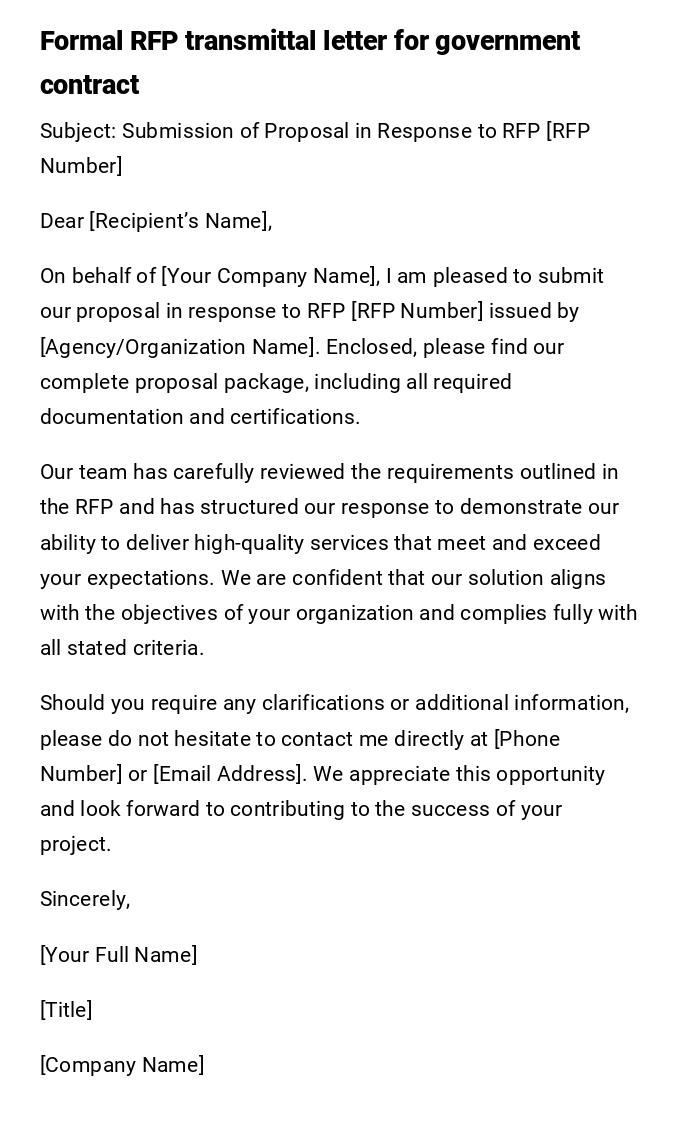
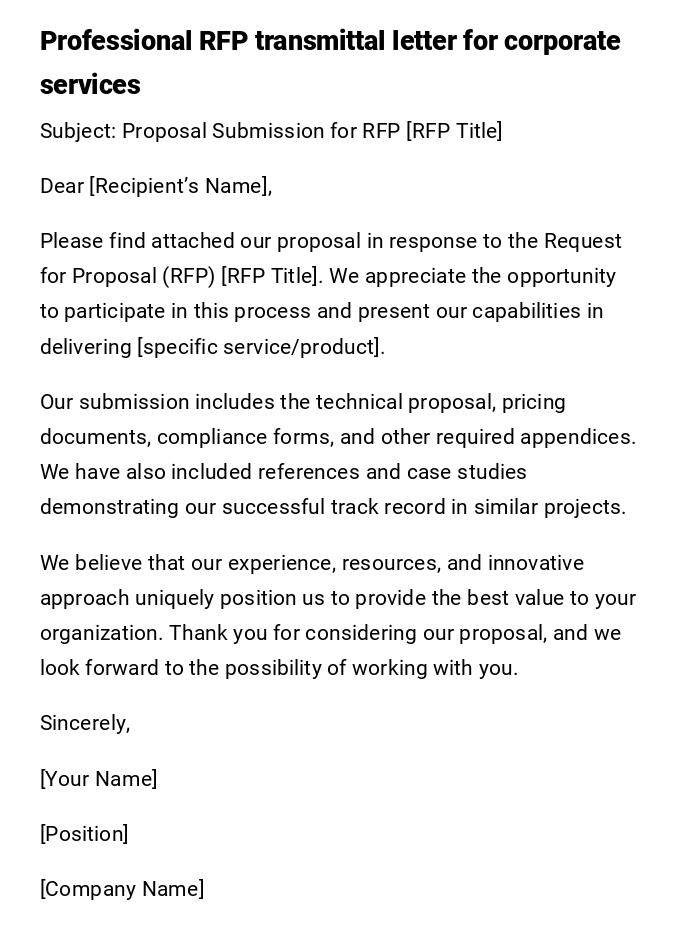
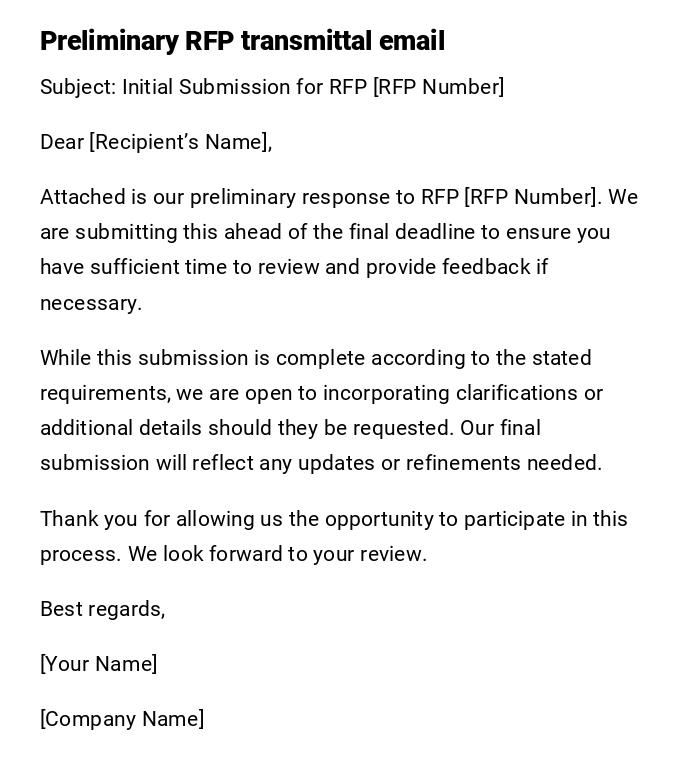
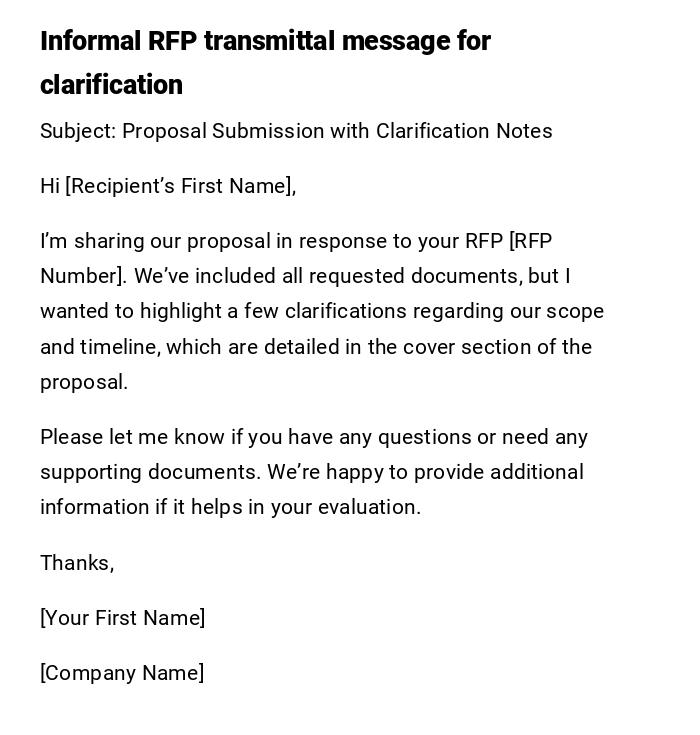
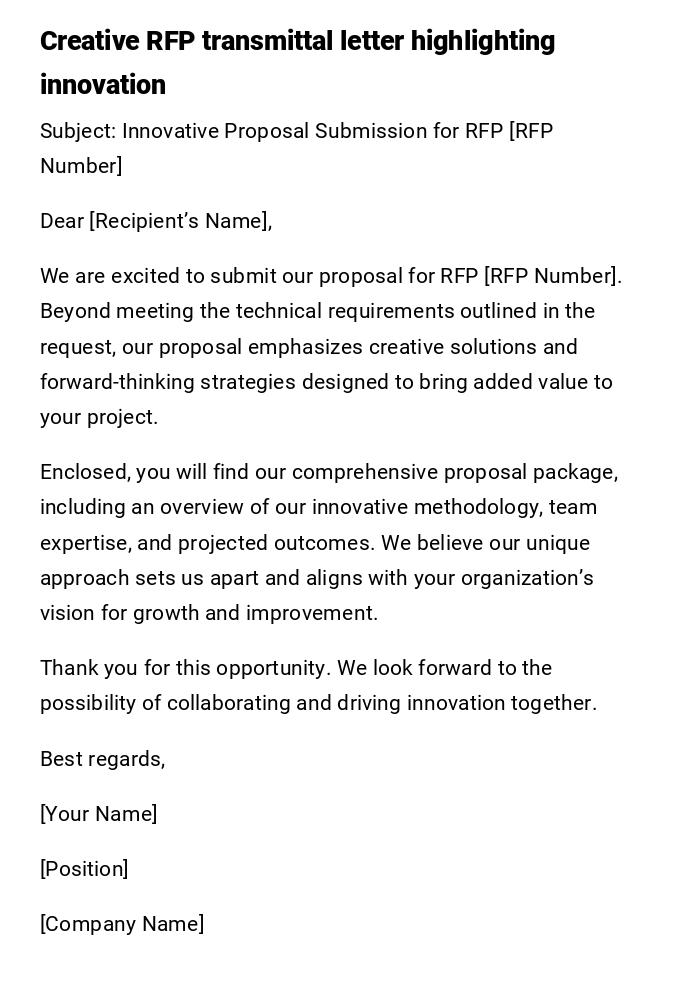
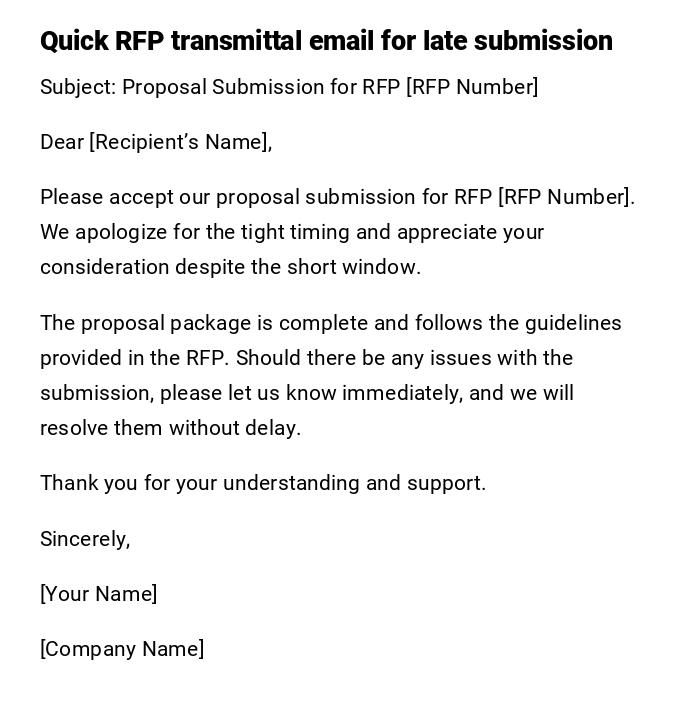
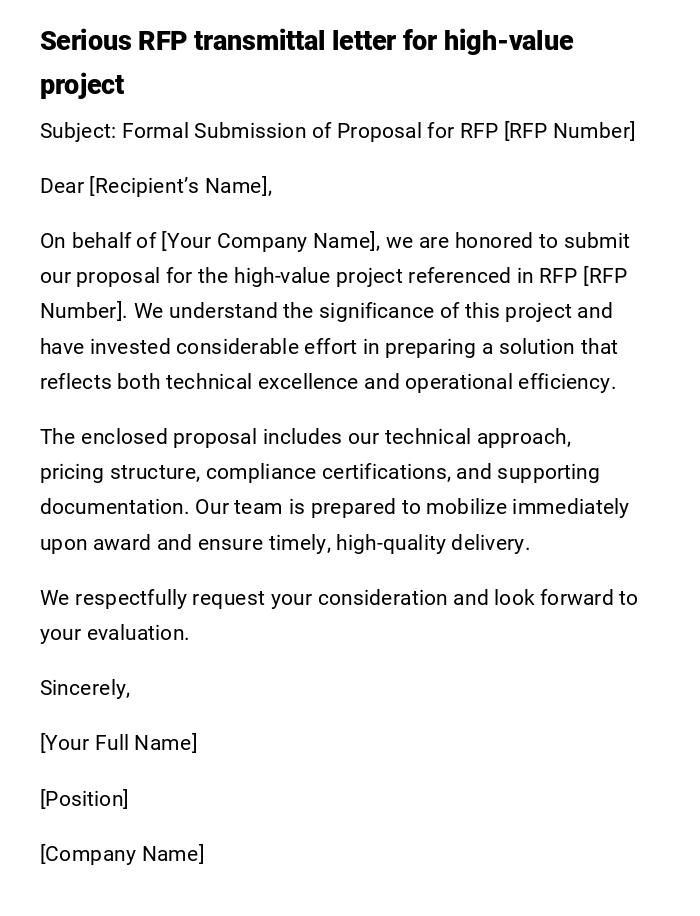
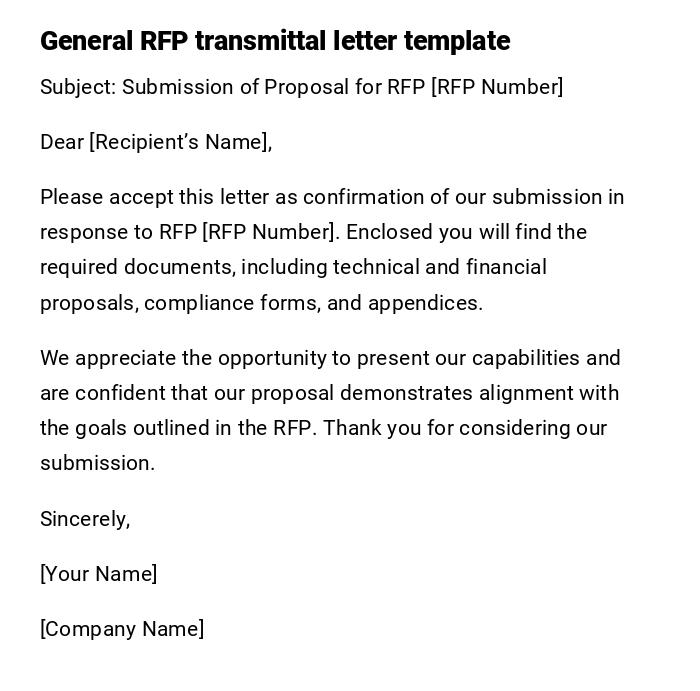

 Download Word Doc
Download Word Doc
 Download PDF
Download PDF